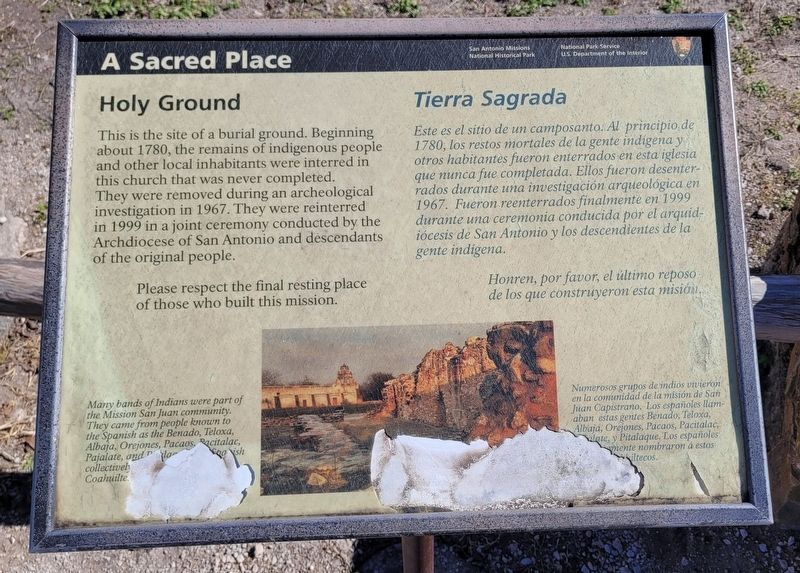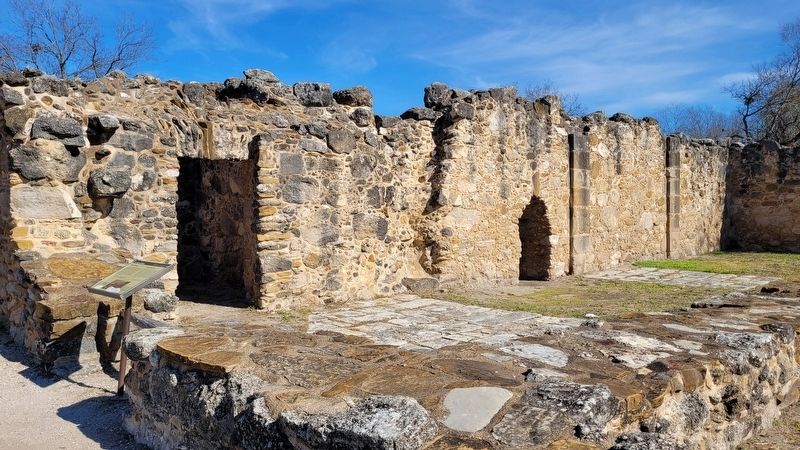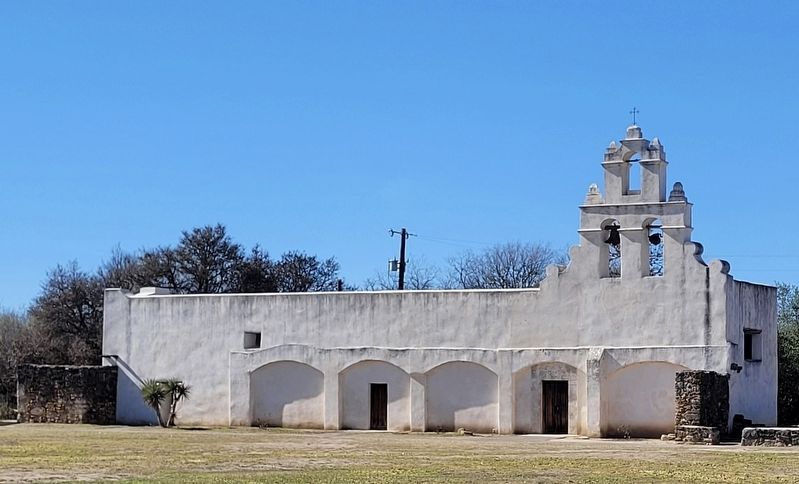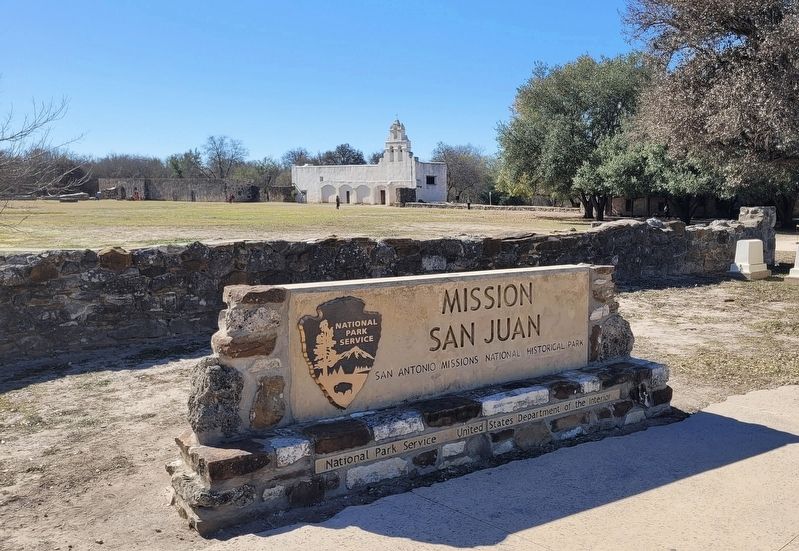Southside in San Antonio in Bexar County, Texas — The American South (West South Central)
A Sacred Place
Holy Ground
This is the site of a burial ground. Beginning about 1780, the remains of indigenous people and other local inhabitants were interred in this church that was never completed. They were removed during an archeological investigation in 1967. They were reinterred in 1999 in a joint ceremony conducted by the Archdiocese of San Antonio and descendants of the original people.
of those who built this mission.
Caption
Many bands of Indians were part of the Mission San Juan community. They came from people known to the Spanish as the Benado, Teloxa, Albaja, Orejones, Pacaos, Pacitalac, Pajalate, and Pitalaque. The Spanish collectively called them the Coalhuilte.
[Spanish Text]
Este es el sitio de un camposanto. Al principio de 1780, los restos mortales de la gente indígena y otros habitantes fueron enterrados en esta iglesia que nunca fue completada. Ellos fueron desenterrados durante una investigación arqueológica en 1967. Fueron reenterrados finalmente en 1999 durante una ceremonia conducida por el arquidiócesis de San Antonio y los descendientes de la gente indígena.
de los que construyeron esta misión.
Subtítulos
Numerosos grupos de indios vivieron en la comunidad de la misión de San Juan Capistrano. Los españoles llamaban estas gentes Benado, Teloxa, Albaja, Orejones, Pacaos, Pacitalac, Pajalate, y Pitalaque. Los españoles mente nombraron á estos ....iltecos.
Erected by San Antonio Missions National Historical Park.
Topics. This historical marker is listed in these topic lists: Anthropology & Archaeology • Churches & Religion • Colonial Era • Native Americans. A significant historical year for this entry is 1780.
Location. 29° 19.94′ N, 98° 27.282′ W. Marker is in San Antonio, Texas, in Bexar County. It is in Southside. Marker can be reached from the intersection of Graf Road and Mission Road. The marker is located in the eastern section of the Mission San Juan. Touch for map. Marker is at or near this postal address: 9101 Graf Road, San Antonio TX 78223, United States of America. Touch for directions.
Other nearby markers. At least 8 other markers are within walking distance of this marker. Hub of Commerce (a few steps from this marker); Mission San Juan (within shouting distance of this marker); Permission to Enter (about
300 feet away, measured in a direct line); San Antonio Missions (about 300 feet away); Mission San Juan Capistrano (about 700 feet away); Bergs Mill Veterans Memorial Bridge (approx. 0.2 miles away); a different marker also named Mission San Juan Capistrano (approx. 0.2 miles away); The San Antonio Missions World Heritage Site (approx. 0.2 miles away). Touch for a list and map of all markers in San Antonio.
Also see . . .
1. Mission San Juan. San Antonio Missions - World Heritage
Mission San Juan Capistrano moved to the San Antonio River from East Texas on March 5, 1731. The unfinished church was utilized as a cemetery and some of the original mission residents were buried there. Today, many of the parishioners are descendants of the original inhabitants of the mission. The Yanaguana Trail along the San Antonio River at the mission is a shaded, paved walkway among trees and vegetation that show you what the riverbank was like 300 years ago. The San Juan Acequia has been restored to use for watering the Spanish Colonial Demonstration Farm.(Submitted on January 7, 2023, by James Hulse of Medina, Texas.)
2. Coahuiltecan Indians. Texas State Historical Association
The lowlands of northeastern Mexico and adjacent southern Texas were originally occupied by hundreds of small, autonomous, distinctively named Indian groups that lived by hunting and gathering. During the Spanish colonial period a majority of these natives were displaced from their traditional territories by Spaniards advancing from the south and Apaches retreating from the north. The Spaniards had little interest in describing the natives or classifying them into ethnic units. There was no obvious basis for classification, and major cultural contrasts and tribal organizations went unnoticed, as did similarities and differences in the native languages and dialects. Spaniards referred to an Indian group as a nación, and described them according to their association with major terrain features or with Spanish jurisdictional units. Only in Nuevo León did observers link Indian populations by cultural peculiarities, such as hairstyle and body decoration. Thus, modern scholars have found it difficult to identify these hunting and gathering groups by language and culture.(Submitted on January 7, 2023, by James Hulse of Medina, Texas.)
Credits. This page was last revised on February 2, 2023. It was originally submitted on January 6, 2023, by James Hulse of Medina, Texas. This page has been viewed 112 times since then and 26 times this year. Photos: 1, 2, 3, 4. submitted on January 7, 2023, by James Hulse of Medina, Texas.



